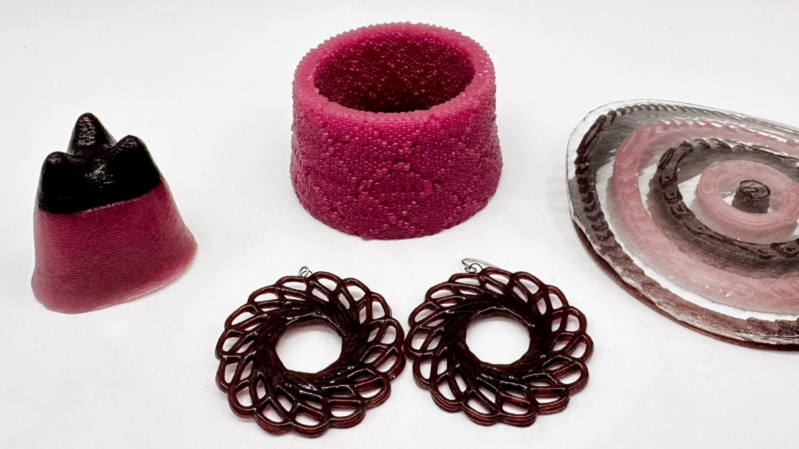In contrast to the success of their molten-plastic cousins, paste extrusion 3D printers have never really attained much popularity. This is shame because, as the [Hand and Machine] research group at the University of New Mexico demonstrate, you can use them to print with some really interesting materials, including glass and eggshell. Links to the respective research papers are here: glass and eggshells, with presentations in the supplemental materials.
To print with glass, the researchers created a clay-like paste out of glass frit, methyl cellulose and xanthan gum as shear-thinning binders, and water. They used a vacuum chamber to remove bubbles, then extruded the paste from a clay 3D printer. After letting the resulting parts dry, they fired them in a kiln at approximately 750 ℃ to burn away the binder and sinter the frit. This introduced some shrinkage, but it was controllable enough to at least make decorative parts, and it might be predictable enough to make functional parts after some post-processing.
Path generation for the printer was an interesting problem; the printer couldn’t start and stop extrusion quickly, so [Hand and Machine] developed a custom slicer to generate tool paths that minimize material leakage. To avoid glass walls collapsing during firing, they also wrote another slicer to maintain constant wall thicknesses.
The process for printing with eggshell was similar: the researchers ground eggshells into a powder, mixed this with water, methyl cellulose and xanthan gum, and printed with the resulting paste. After drying, the parts didn’t need any additional processing. The major advantage of these parts is their biodegradability, as the researchers demonstrated by printing a biodegradable pot for plants. To be honest, we don’t think that this will be as useful an innovation for hackers as the glass could be, but it does demonstrate the abilities of paste extrusion.
The same team has previously used a paste printer to 3D print in metal. If you don’t have a paste printer, it’s also possible to print glass using a laser cutter, or you could always make your own paste extruder.
















See http://www.filament2.com – paste 3d printing using regular filaments.
were you scared of CF cancer inducing fibers?
wait till you hear about glass containing ones !
Coarse (on the nanometre scale) glass frit is nothing compared to fibrous CF and other asbestos-like nanoscale javelins. Even if you use powder frit (rather than the 0/00 that appears to be in use here) with an actual silicosis risk, the powder is contained within the paste. This is unlike in FDM, where the filament is heated and offgasses, carrying with it aerosolised filler material (including your CF fibres).
Maybe hold off on pooh-poohing risks until you actually understand them (e.g. cancer is a secondary risk to asbestosis when it comes to aerosolised nanoscale fibres).
Are you sure about those numbers? None of the materials you mention are typically in the nanometer scale, except perhaps the very finest frit at 0.1 um (100 nanometers) Asbestos concerns, in particular, is in the several micron scale, not nanoscale. And “Coarse” glass frit is in the tens of microns, most emphatically not “nanometre scale”)
“research group at the University of New Mexico” not exactly a DIY project then.
Its a motorized syringe in place of an extruder. Theyve been built by tons of hobbyists in the past. Theres nothing stopping you from DIYng this.
Well not with that attitude
Which is to say that more research is needed in order to make the shrinkage uniform.
This is for all the writers and editors, not just you— I really enjoy the writing, but then I run into “we don’t think…” I’m getting so tired of the “we” (and please stop calling it “royal”: look it up, it’s called the editorial “we”). Many of the writers here do it, but not in a way that makes any sense. Did you ask anyone else if they think that the eggshell printing (which is pretty cool) is a useful innovation? Isn’t it really just you? Own your opinions and stop saying “we” as if it lends more credence to your personal views. It isn’t journalism: it’s disingenuous, insincere, and insinuates that the whole staff of a respected tech blog agrees with you. It’s a cheap trick, and beneath you (plural). I’m actually interested in the biodegradable eggshell printing, but your article is biased towards it being irrelevant, so you didn’t give it a fair write-up. I don’t care if the (editorial, not royal) “we” is a part of your style guide, it’s incorrectly (or untruthfully) being used to signify the agreement of the staff or the readers. I mean, think about it: you write about an innovative 3d printing process using paste extrusion with novel materials, but you think only the glass material is innovative and insinuate that everyone agrees. Let the opinions battle it out in the comments where they belong. (Unless this is just super-deep trolling: Benchoff?)
If you trust journalists just because they say “I” instead of “we” then I have a bridge to sell you.
If the story is checked — even in a cursory manner — by an editor, that justifies the plural.
We always run posts by an editor. And when the piece is clearly a personal-experience thing, we write in the first-person singular.
Otherwise, the giant-Hackaday-hivemind writes in the plural, and has for ~20 years now.
We’re sorry for any inconvenience this may cause. :)
lots of words to bother someone else about a personal problem. We think its for of a you problem than an us problem.
I’ve always said “paste extrusion is the way”, but no one would listen. Now look where we are.